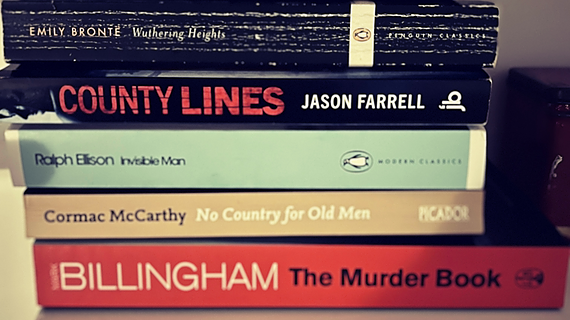
The Murder Book by Mark Billingham
No Country for Old Men by Cormac McCarthy
Invisible Man by Ralph Ellison
County Lines by Jason Farrell
Wuthering Heights by Emily Bronte
Beyond Belief by Emlyn Williams
FEBRUARY BOOKS 2023
February is a short month so it's a short stack but they all packed a punch. Grim cold days make for grim cold reading and I feel much enriched for them. The most satisfactory reads were, once again, the narratives fleshed around cold facts: Beyond Belief, No Country, County Lines. I'm super grateful to indie and second hand bookstores where I can get out-of-print titles. I treasure books more now than ever. I can't remember the last time I watched TV or saw a film; I usually get bored within five minutes even when I try. Thank goodness for writers who convey the worlds we need to understand - not the ones we do.
NO COUNTRY FOR OLD MEN by Cormac McCarthy
Although Cormac McCarthy originally penned this as a screenplay, I think it works perfectly as a novel. I’ve seen bits of the film (but never got engaged enough to watch more than a few minutes at a time) but the characters and settings of the novel are burned within my brain. I think I would be disappointed if I was to watch the film now. I think, despite its title, the irony is how innocent it feels compared to what is now common knowledge about the border shenanigans between the US and Mexico. I love the characterisation of Llewellyn Moss and Ed Tom Bell, his prescient wife and the amoral blur of Chigurh. He is the one faceless, plasticine character. I never even feel him as bad – just as a blur, a void with a gun. The novel starkly recounts the end of an era and the beginning of an unbrave new one. I can never find anything to fault with Cormac McCarthy – apart from the fact he should write more books. He writes lean, vital prose that invites – rather than dictates – the imagination. Don’t ask me how or why but, however bleak his tale, I always leave a chapter reluctantly and feeling oh, so much better than when I started.
COUNTY LINES by Jason Farrell
Written from a polemical TV journalist’s PoV, it’s a bit of a slog through the list of info and basic, A level analysis but it does enable a timeline of events and how/when the real horrors started to be revealed. County Line have been run for decades but it’s only become a ‘thing’ and exploded since austerity kicked in twelve years ago and the London grime scene propagated its world view and vernacular into every nook and cranny of the British isles. Whether they accept responsibility or not, the DIY grimestars as well as the terrorists are not just victims but predators, fanning the flames still for the poor and desperate.
BEYOND BELIEF – The Story of Ian Brady and Myra Hindley by Emlyn Williams
Is just not what I thought it would be. It’s a blend of facts, newspaper headlines, imagined conversations, the minutiae of the lives of victims and culprits without any heavy-handed analysis or third person narrator. In fact, he dips and dives between second person, to third to fourth, subtly weaving the net to include the reader in this complicit act. Growing up on the other side of Saddleworth, I was always told ‘the Moors murderers were monsters’ but in this detailed, friendly little paperback, the real horror is in how very un- monstrous they were - before their acts revealed otherwise.
How very mediocre. The exiled Scot, Ian Brady, and Ian Curtis were almost twins give a few years. Their interests, need for success and demand for attention, their social circumstances. But while Curtis was overcome by empathy and social responsibility, Brady sought to cover his shame and idleness through narcissistic fetish.
What Williams reveals is the stark ‘normality’ of both Brady and Hindley and therein points a figure at the working class community that accommodated the germination of their monstrous perversion. The book opens with a description of AnyTown on AnyRoad out of Greater Manchester going towards AnyMoor, the dull dehumanisation and cheapening of life till it arrives at its logical conclusion: Ian Brady and Myra Hindley. A pair born every minute.
This book is not graphic, not for the voyeur or the true crime vulture. But at the end, you are left with the inescapable feeling that ‘evil’ is not some distortion of the psyche, nor an outlier on the psychiatrist’s DSM (as Brady wished to be seen) but terrifyingly ordinary, mundane, as prosaic as the language itself, the child of nothing more callous than the chronic neglect of the child.